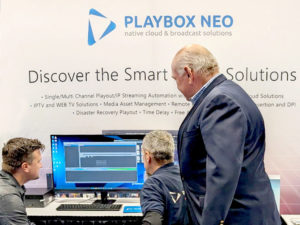LTN – Looking beyond satellite and fiber: why it’s time to transition to IP

Roger Franklin, Chief Strategy Officer, LTN
In the pre-streaming age, video delivery and consumption were simpler. Feeds consisted of fixed content transmitted from a single source to a broad audience via cable or broadcast networks, and there was little room for targeted segmentation. Fast forward to today, and audiences are scattered across multiple streaming platforms, channels, and devices. This has meant that media companies face the challenge of creating diverse experiences that capture their attention while also tailoring content to deepen engagement — all while maximizing profitability.
Linear distribution methods, like satellite and fiber systems, had their place in the evolution of video distribution. However, they fall short when addressing the complexities of the modern media landscape. IP video distribution has now cemented itself as the leader in this space, offering media companies greater efficiency, scale, and monetization that satellite and fiber can no longer match.
The disadvantages of satellite video distribution
It’s no secret that satellite workflows have become increasingly complex and untenable for today’s market. Media companies are grappling with the dual pressures of meeting insatiable content demands while facing the constraints of shrinking satellite bandwidth. As 5G wireless carriers repurpose satellite capacity, media transmission pathways narrow, leading to interference issues. Troubleshooting becomes time-consuming, and resource reallocation disrupts transmission traffic. The clash between content abundance and limited satellite resources necessitates a more agile solution.
As digital consumption of video content grows and evolves, media companies need the space to experiment with new channels and live event feeds quickly and efficiently. They also need the agility to modify them based on changing viewer preferences and the scalability to reach both global and hyperlocal audiences across multiple platforms and devices. Satellite video distribution is far too rigid to meet these demands, and it does not offer the flexibility required for navigating rapid changes in the media landscape.
The limitations posed by fiber video distribution
Fiber was intentionally designed for content to be distributed by one source to a select few contracted distribution outlets. This inherently limits its reach and customization capabilities. Media companies using fiber video distribution are missing key revenue-generating customization opportunities, such as being able to provide targeted, relevant audience segments.
Vulnerable to signal loss caused by manufacturing flaws, environmental and construction interference, and general corrosion over time, the fragility of fiber is impossible to overlook. Unless reinforced with the installation of multiple fiber paths — which is complicated and costly to achieve — the lack of redundant routes can threaten video transport and lead to network disruption that can be expensive to diagnose and repair, requiring specialized service and equipment.
These issues could make satellite and fiber video distribution models too costly for media companies as it will stifle the potential for greater business agility and innovation at a time when the landscape demands it.
Greater efficiency and scale with IP video distribution
Public internet’s basic structure doesn’t include the native ability to multicast or support both low latency and high reliability. When there are periods of high use, this means that internet routing protocols can be overwhelmed by traffic, causing jams that can lead to packet delays or loss. With live video distribution, there are no second chances, and the economic implications for these issues can be costly. It is critical that media companies have a robust network that can mitigate these obstacles in order to retain and grow their viewership.
This is where the value of a proprietary IP network becomes invaluable for effectively addressing today’s challenges and achieving reliable, cost-effective delivery of live and on-demand content.
IP video distribution is giving media companies greater control of their full video chain workflows, enabling them to customize with efficiency and scale. Compared to the rigidity and expense of fiber and satellite video distribution, IP video distribution via a proprietary network enables media companies to tailor content efficiently and at scale. Unlike fiber and satellite video distribution or multicast transport, investing in the right IP video distribution infrastructure will empower simultaneous and multiple distribution and customization of high-value content worldwide. This scalable and efficient customization offers the opportunity to make every event and every second of a video stream an asset that maximizes monetization.
Driving long-term business growth
It’s not uncommon for media companies to have one foot in digital content delivery and the other in legacy linear distribution, seeking a hybrid approach that offers greater flexibility and revenue. Having a future-ready digital strategy in place that incorporates IP video distribution will be key to giving media companies that edge to greater monetization.
IP video distribution boasts new capabilities and advantages that go beyond what satellite or fiber can offer. The value of content is transformed by IP video distribution. Through the ability to deploy high-quality content, media companies have access to a new revenue stream that satellite is not able to provide.
Tier 1 media companies around the world are no longer viewing the transition to IP video distribution as something they have to do — it’s now something they want to do to expand their reach both globally and hyper locally, monetize video content, and ensure ultra-low latency and high reliability.









